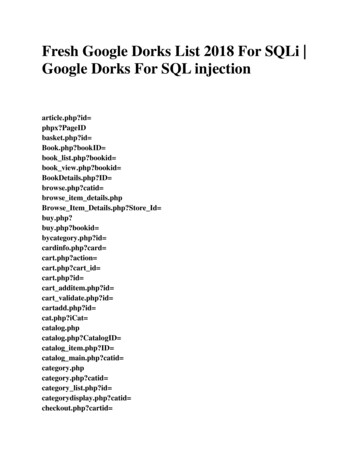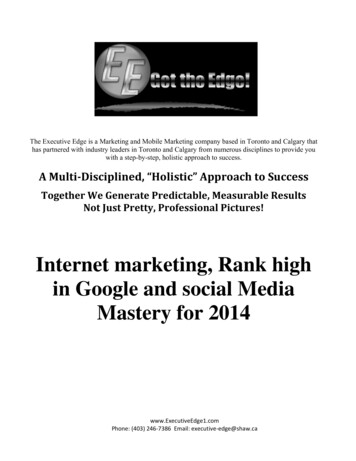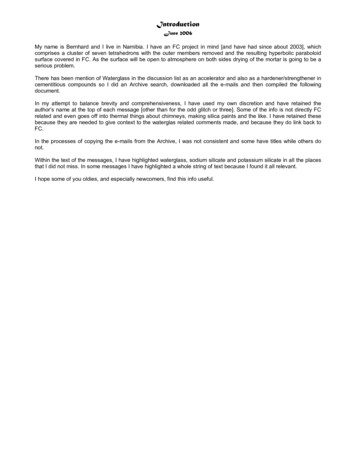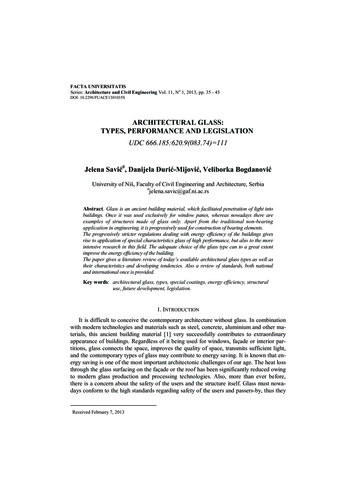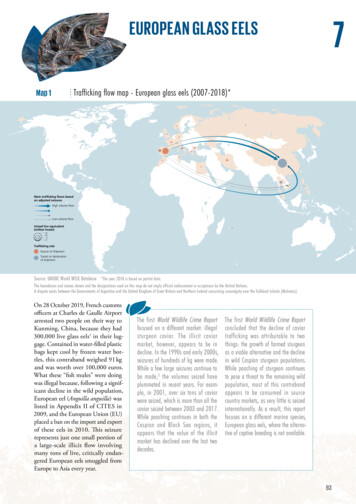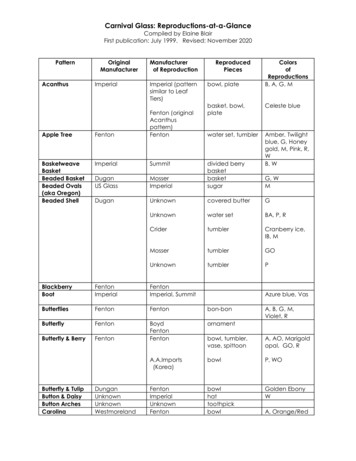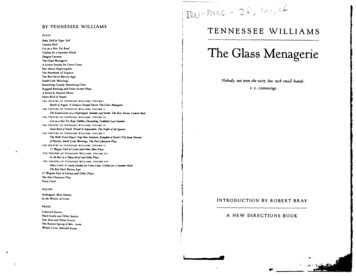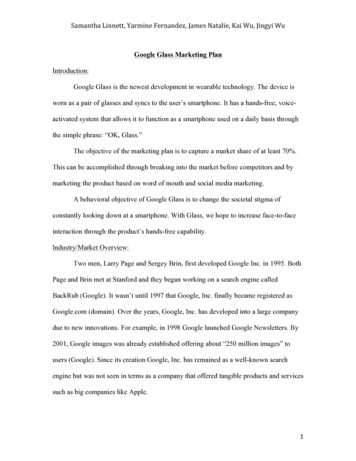
Transcription
u,JingyiWuGoogle Glass Marketing PlanIntroduction:Google Glass is the newest development in wearable technology. The device isworn as a pair of glasses and syncs to the user’s smartphone. It has a hands-free, voiceactivated system that allows it to function as a smartphone used on a daily basis throughthe simple phrase: “OK, Glass.”The objective of the marketing plan is to capture a market share of at least 70%.This can be accomplished through breaking into the market before competitors and bymarketing the product based on word of mouth and social media marketing.A behavioral objective of Google Glass is to change the societal stigma ofconstantly looking down at a smartphone. With Glass, we hope to increase face-to-faceinteraction through the product’s hands-free capability.Industry/Market Overview:Two men, Larry Page and Sergey Brin, first developed Google Inc. in 1995. BothPage and Brin met at Stanford and they began working on a search engine calledBackRub (Google). It wasn’t until 1997 that Google, Inc. finally became registered asGoogle.com (domain). Over the years, Google, Inc. has developed into a large companydue to new innovations. For example, in 1998 Google launched Google Newsletters. By2001, Google images was already established offering about “250 million images” tousers (Google). Since its creation Google, Inc. has remained as a well-known searchengine but was not seen in terms as a company that offered tangible products and servicessuch as big companies like Apple.1
u,JingyiWuGoogle Inc. began to offer products starting in 2002. The first product thatGoogle, Inc. offered was “Google Search Appliance, a yellow box that businesses canplug into their computer network to enable search capabilities for their own documents”(Google). Additional products and services that Google offers are Google AdSense,Google Grants, Google Print, Gmail, Picasa, Google maps, Google Mobile Web Search,and Google Chrome, etc. Most of these products and services are not physical products,however. Google Inc. launched its first open platform for mobile devices, also known asAndroid, which then phone companies like T-Mobile used for phones like the G1(Google).The needs that Google’s products and services satisfy vary on the actual productand service. For example, Gmail satisfies the needs for users that want to keep in contactwith others and prefer more storage for their electronic information. Google Glass in thiscase serves the needs of people that want a technological device like their phones, buttranslated into a simple pair of eyeglasses. Similarly, the industry serves the commonpublic; especially the generation that is tech savvy and understand the dynamics oftechnology in a broader spectrum.Competitive Analysis:Google, Inc. has grown into a company that serves several aspects and is not justfocused on one product or service. The fact that they have made this possible allows forGoogle to have competing firms. In terms of email and search engines, Google’scompeting firm would be Yahoo! and Bing owned by Microsoft. Whereas for physicalproducts that Google offers such as phones, and Google Glass, Apple would be theirnumber one competitor. For market share and profitability, Yahoo! Inc. is currently worth2
u,JingyiWu 25.6 billion in comparison to Google’s 339.4 billion worth (Yahoo!). Apple Companyis a stronger competitor to Google because its shares and profitability equates to 520.56billion (Google).The products and services offered by Yahoo! Inc. are email, Flickr, Tumblr, and ithas partnerships with ABC News, CBS, NBC, and Hulu, etc. By contrast, AppleCompany offers products and services such as the iPhone, iPad, iPod, iMac, and MacBook, etc. Yahoo! Inc. is targeting the common public (both female and male ages 15 to50) like Google because it essentially offers the same search capabilities. For Yahoo! Inc.no price, sales and locations where they sell, can be determined because it just serves thegoal of a search engine/website. The way in which they promote is through theirpartnerships and commercials, which has significantly decreased over the years. Yahoo!Inc. compared to Google has very little strengths and a lot of weaknesses. One majorweakness is that it has become less popular to use and people are more likely to create aGmail account because of storage size. Their strengths include news updates and weatherforecasts, which is accessible and accurate information.Finally, for Apple Company the prices for their technological products can rangefrom 99 up until 5000, which is dependent upon the type of product. For example, theiriPad Air costs about 500. In regards to Apple Company’s target audience, they target amore tech savvy public, such as both females and males aging from 17 to 40 (Apple).Apple currently sells in all 50 states and in 14 countries, including Italy, Hong Kong, andCanada. Apple Company promotes through commercials, their website, billboards andadvertisements. Apple’s strengths are reaching a large number of people to buy theirproducts and the effectiveness of their products. Apple’s weaknesses could potentially be3
u,JingyiWuhow overpriced their products can be and how advanced their products are to the pointthat an older generation might not understand how to use it.Situational Factors:Outside of competition, there are other factors that will influence the market forGoogle Glass. One of those factors is technology. Google Glass has been in developmentfor years. The concept of wearable technology is something that all of the majortechnology companies are working to make their own. The technology exists, GoogleGlass just happens to be the one having the most success at taking advantage of it.This high level of technology creates a high cost to entering and exiting thismarket without having been already established in it. This leaves the market of wearabletechnology to the advantage of big technology companies like Google and Apple to raceagainst each other to create the best product. This limited competition could be a majorfactor when it comes to the pricing of these different products.The market open to wearable technology is huge, but certain consumer trends willreduce this size. While there are a large number of technology enthusiasts who are eagerand excited to have this new kind of wearable technology available to them, there are alsoa great number of technology skeptics. Many people, with the release of Google Glass,will wonder just where the advancement of technology stops. Even some smartphoneusers are likely to be weary of the device and what effects it will have on society’s viewsand the use of technology. This will make it ever more important to highlight theadvantages of the device over the societal technological risks.Legal issues, of course, play into this skeptical role. Google Glass is essentiallythe consumer’s smartphone right in front of their face. Although you have to look up at4
u,JingyiWuthe screen for it to be in your field of view, the ease of access poses certain safetyproblems, especially while driving. Google Glass Explorers, people chosen to test out andmarket the prototype of Google Glass, have already been pulled over and ticketed fordriving with the device on. It poses a large risk of distraction and will likely cause issuesin redefining laws about the use of cell phones while driving.Opportunities and Threats:Google has a huge opportunity to take advantage of the timing of Google Glass.The sooner it can release the product, the better. While competitors such as Apple aredeveloping different forms of wearable technology, such as a touch-screen smartphonewatch, they are not as close to being able to release them as Google is, and they are not ofthe same form. Many of the competitors developing products promote ease of use andhands-free capability in the same way as Glass, but none are as unique and convenient.Google needs to seize the opportunity of capturing a major portion of the market sharefor wearable technology by getting in the game before its competitors even have achance.The biggest threat that Google will face in the marketing of Google Glass will beto overcome the legal issues of safety. Google Glass is safe to have on while driving, andworks as an extremely convenient, voice-driven GPS, as long as the driver isn’t misusingit. However, the knowledge that is dangerous in the form of a distraction when misusedwill be a legal issue that isn’t likely to be won. It will be crucial for Google to focus onthe hands-free advantage of Glass and steer away from references to use while driving.5
u,JingyiWuMarketing Strategy Statement:Google Glass, as an innovative product of high technology and high quality, shouldbe able to evoke a revolution in electronic device markets. Combined with a Google account, Google Glass will provide its users with joyful experiences through the use ofsimilar functions as a smartphone such as hands-free technology. As Google is a worldrenowned search engine and relevant online service company, this brand is of greatcredibility. Just as Jonah Berger stated in the book “Contagious,” one of the ways topopularize a product or an idea is to “make private public.” With its unique look and theunbelievable functions, it can draw the attention of many people, especially the young,who may define it as cool and try to imitate it, and the brand equity of Google Glass canstand out among other products if it can sustain its advantage as a multifunctional hightech glasses with a distinct look.To develop and enhance the brand equity, Google Glass can co-brand withoptometrists and eyeglass stores as well as co-brand with communication companies likeAT&T and T-Mobile, since it is capable of syncing to a smartphone.Facing the fierce competition from the electronic device market, Google Glassshould not only be viewed as a high quality, high-tech, innovative product, but also as arevolutionary means of communication for people. Ever since the start of social medialike Facebook and Twitter, people’s means of communication has changed. The face-toface communication transitioned into the posting of personal comments and sharinginteresting information online to friends. The launch of Google Glass can mark thebeginning of the next era for communication. With the help of Google Glass, people nolonger need to look down at their phone frequently to check text messages or e-mails, and6
u,JingyiWucan spend more time hanging out with their friends rather than sitting in front of acomputer screen the whole day.The target market of Google Glass is the smartphone users, and the age of itsconsumers, should be college age and above. Google Glass may not be a luxuryelectronic device, but it is still not affordable to everyone. For teenagers, they have to relyon their parents for getting one, and Google Glass might be distracting for them, asthey’re too young to have self-control. Thus, Google Glass should be fit for adults whoare frequent smartphone users, and can afford it.Right now, the price of Google Glass for explorers is 1500. This price is expected tofall to around 600 in 2014, which would lead to a large growth in sales. According tothe BI Intelligence, unit sales of Google Glass are going to climb sharply in the next fewyears, to about 21 million units in annual sales by year-end 2018. At 500 per unit, thisequates to a 10.5 billion in annual market opportunity.Objectives:As Google Glass is the first and the only product in the industry, we want tocapture as much of the market share as possible. We want to keep the product in a higherthan-average price, so it will be important to keep the product at a high quality. Tocompete with the substitutes and the other entrants in the future, Google Glass needs tokeep a reputation as innovative, easy-to-use, multi-functional, and high quality.Additionally we know that mobile phones are distracting to people in manydifferent situations. We can find people checking their phones when they gather togetherand avoid talk and eye contact. To introduce Google Glass to the market, we want tochange people’s behavior and encourage them to look into others’ eyes and show7
u,JingyiWufriendliness. People won’t be tempted to check their phones when they receive messagesbecause with Google Glass, they could see the new message instantly. Google glass canalso free people’s hands because it is voice activated. People simply need to say “OK,Glass” to reply to a message, make a phone call or take pictures and videos. People willbe safer because they won’t have look down to their phone and they can pay attention tothe environment around them. Our objective is to change the way people live byintroducing Google Glass.We will measure our success through customer satisfaction, the percentage ofmarket share, the growth rate and through activity on social media. Our goal is to get atleast 70% market share in the market and maintain it. We also want to make GoogleGlass the favorite product among other wearable high-tech products.Competitive Advantage:The competitive advantage of the product is that Google Glass is developed bythe pre-established, well known company—Google. Google also has Google , GoogleMap, and Gmail, all which could be supportive applications of Google Glass. GoogleGlass can work more effectively and efficiently with these applications. People maychoose Google Glass instead of other products just because they like and are regular usersof the other applications developed by Google.Marketing Tactics:Given that Google Glass i
Google Glass Marketing Plan Introduction: Google Glass is the newest development in wearable technology. The device is worn as a pair of glasses and syncs to the user’s smartphone. It has a hands-free, voice-activated system that allows it to function as a smartphone used on a daily basis through the simple phrase: “OK, Glass.”
